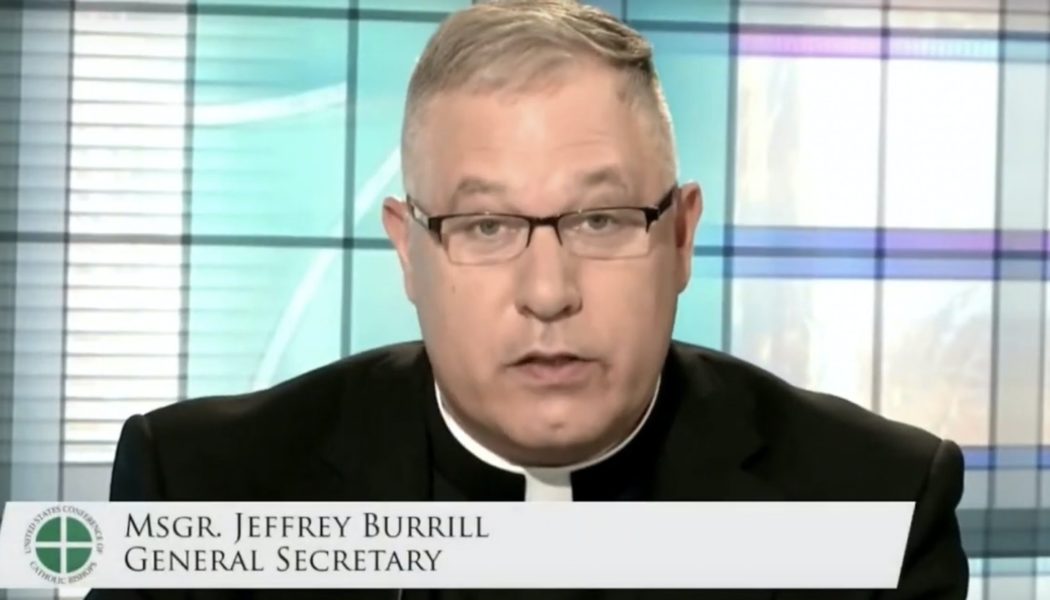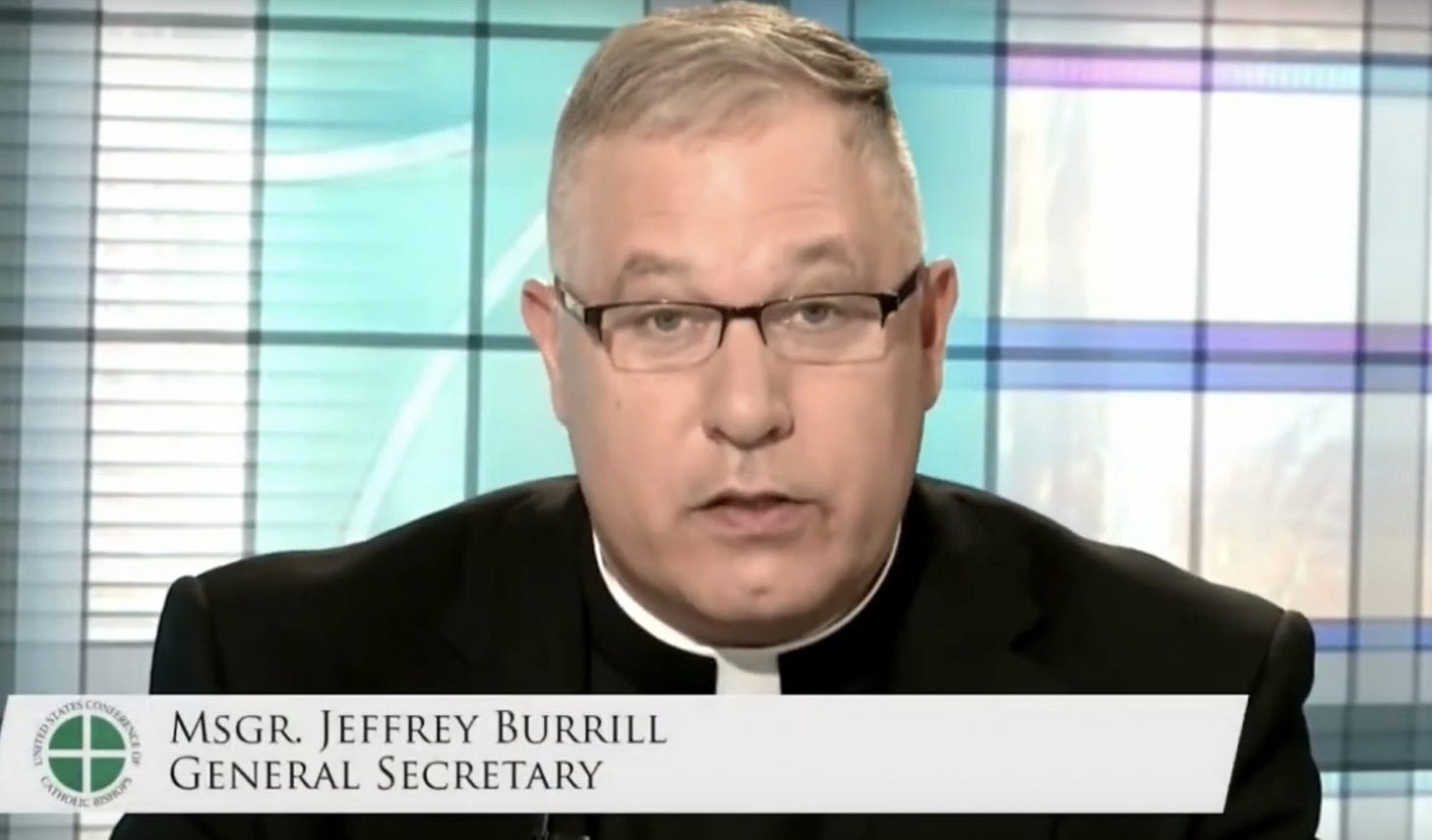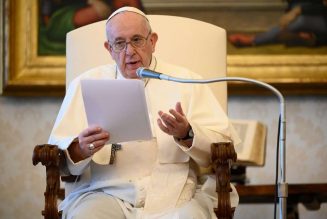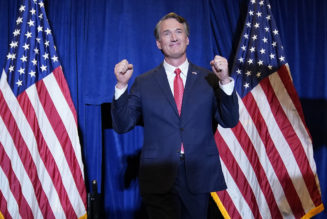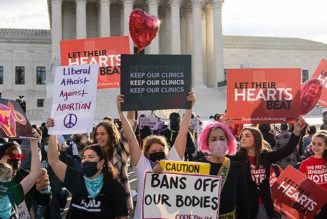Monsignor Jeffrey Burrill, former general secretary of the U.S. bishops’ conference, announced his resignation Tuesday, after The Pillar found evidence the priest engaged in serial sexual misconduct, while he held a critical oversight role in the Catholic Church’s response to the recent spate of sexual abuse and misconduct scandals.
“It is with sadness that I inform you that Msgr. Jeffrey Burrill has resigned as General Secretary of the Conference,” Archbishop Jose Gomez wrote July 20 in a memo to U.S. bishops.
“On Monday, we became aware of impending media reports alleging possible improper behavior by Msgr. Burrill. What was shared with us did not include allegations of misconduct with minors. However, in order to avoid becoming a distraction to the operations and ongoing work of the Conference, Monsignor has resigned effective immediately,” Gomez added.
The memo came after the USCCB and Burrill were contacted by The Pillar regarding evidence of a pattern of sexual misconduct on Burrill’s part. Burrill did not respond to questions from The Pillar before his resignation was announced to bishops.
Burrill was elected general secretary of the U.S. bishops’ conference in November 2020. In that role, Burrill was effectively the highest-ranking American cleric who is not a bishop.
A priest of the Diocese of La Crosse, Wisconsin, he first began to work at the bishops’ conference in February 2016, when he began serving as associate general secretary. In that capacity, the priest was charged with helping to coordinate the U.S. bishops’ response to the Church’s 2018 sexual abuse and coercion scandals.
But an analysis of app data signals correlated to Burrill’s mobile device shows the priest also visited gay bars and private residences while using a location-based hookup app in numerous cities from 2018 to 2020, even while traveling on assignment for the U.S. bishops’ conference.
According to commercially available records of app signal data obtained by The Pillar, a mobile device correlated to Burrill emitted app data signals from the location-based hookup app Grindr on a near-daily basis during parts of 2018, 2019, and 2020 — at both his USCCB office and his USCCB-owned residence, as well as during USCCB meetings and events in other cities.
In 2018, the priest was a member of the USCCB’s executive staff and charged with oversight of the conference’s pastoral departments. He and several senior USCCB officials met with Pope Francis Oct. 8, 2018, to discuss how the conference was responding to ecclesiastical scandals related to sexual misconduct, duplicity, and clerical cover-ups.
Burrill, then second-in-command at the conference, is widely reported to have played a central role in coordinating conference and diocesan responses to the scandals, and coordinating between the conference and the Vatican.
Data app signals suggest he was at the same time engaged in serial and illicit sexual activity.
On June 20, 2018, the day the McCarrick revelations became public, the mobile device correlated to Burrill emitted hookup app signals at the USCCB staff residence, and from a street in a residential Washington neighborhood. He traveled to Las Vegas shortly thereafter, data records show.
On June 22, the mobile device correlated to Burrill emitted signals from Entourage, which bills itself as Las Vegas’ “gay bathhouse.”
The Grindr app and similar hookup apps use mobile device location data to allow users to see a listing of other nearby users of the app, to chat and exchange images with nearby users within the app, or to arrange a meeting for the sake of an anonymous sexual encounter.
Commercially available app signal data does not identify the names of app users, but instead correlates a unique numerical identifier to each mobile device using particular apps. Signal data, collected by apps after users consent to data collection, is aggregated and sold by data vendors. It can be analyzed to provide timestamped location data and usage information for each numbered device.
The data obtained and analyzed by The Pillar conveys mobile app date signals during two 26- week periods, the first in 2018 and the second in 2019 and 2020. The data was obtained from a data vendor and authenticated by an independent data consulting firm contracted by The Pillar.
The Pillar correlated a unique mobile device to Burrill when it was used consistently from 2018 until at least 2020 from the USCCB staff residence and headquarters, from meetings at which Burrill was in attendance, and was also used on numerous occasions at Burrill’s family lake house, near the residences of Burrill’s family members, and at a Wisconsin apartment in Burrill’s hometown, at which Burrill himself has been listed as a resident.
The Pillar approached USCCB officials last week, offering to present findings regarding personnel misconduct to USCCB leadership during an off-the-record meeting before publication, and then allowing the conference time to formulate its internal response.
The conference initially scheduled a meeting with The Pillar for Monday, July 19, but on Sunday the conference cancelled the meeting, and said it would only respond to written questions, which The Pillar submitted late Sunday night, requesting a response by Monday afternoon.
The USCCB asked for additional time to respond, and The Pillar offered again a willingness to meet, while agreeing to delay publication in order for conference leaders to devise their response. The conference sent on Tuesday morning responses to questions from The Pillar and requested a meeting Tuesday afternoon for further information, in order to investigate the claims against Burrill — the same information which The Pillar had planned to convey at the initially scheduled meeting.
Bishops were notified before the USCCB’s Tuesday afternoon meeting with The Pillar that Burrill had resigned.
Use of location-based hookup apps is inconsistent with clerical obligations to continence and chastity, according to Fr. Thomas Berg, a professor of moral theology at St. Joseph’s Seminary in Yonkers, New York.
Berg told The Pillar that “according to canon law and the Church’s tradition, clerics are obliged to observe ‘perfect and perpetual continence,’ as a reflection of what should be our lived pursuit of our spousal relationship with the Church and with Christ.”
Calling it “obviously a scandal” that a cleric would use location-based hookup apps, Berg said there is “a real disconnect between the appearance of a man who presumably is earnestly striving to live the life of chastity, when it becomes glaringly evident that he is dramatically failing at that because he’s gone to hookup apps to look actively for sexual partners — that itself is an enormous scandal.”
In his experience in formation and religious life, Berg said that “when it becomes evident that a cleric is regularly and glaringly failing to live continence,” that can become “only a step away from sexual predation.”
The issue is compounded when a cleric in a position of ecclesiastical authority is found to “engage in a double life,” Berg said.
“That almost always impacts the lives of other people around them because deception breeds deception breeds deception.”
The use of location-based hookup apps has in recent years presented challenges to the Church’s child protection efforts.
There is no evidence to suggest that Burrill was in contact with minors through his use of Grindr. But any use of the app by the priest could be seen to present a conflict with his role in developing and overseeing national child protection policies, as Church leaders have called in recent months for a greater emphasis on technology accountability in Church policies.
An Ohio priest will enter a guilty plea to federal child pornography and exploitation charges, after he was indicted last year for numerous counts of child sex trafficking, sexual exploitation, and child pornography charges. The priest, Fr. Robert McWilliams, used Grindr to meet a 15-year-old boy whom he paid for sex on multiple occasions. McWilliams also posed as a woman on social media to meet minor male victims, some of whom were parishioners, whom he coerced into sending sexually explicit photos and videos. The priest subsequently used the photos, and the threat of blackmail, to coerce minors into sending additional photos and videos.
In Italy, the United States, and Ireland, at least seven priests and deacons in recent years have been arrested or faced charges after using hookup apps to meet or solicit minors for sex, solicit child pornography selfies from minors, or blackmail and extort minors who provided child pornography.
Grindr and similar apps have come under fire in recent years among child protection advocates, who say that because the apps prioritize anonymity and confidentiality without doing enough to screen users for age, they have become a frequent point of contact between minors and adults interested in soliciting pornographic photographs or meeting for sexual encounters. In some cases, minors are marketed for prostitution through hookup apps, sometimes by adult pimps, studies have found.
The age of consent varies among states. In 13 states the age of consent is 18, but in many others, including Nevada and Maryland, it is 16. In the Church’s penal law, a minor is classified as anyone under the age of 18, and sexual contact below that age is treated as a reserved delict, or major crime, in canon law.
The Grindr app says it does not permit minors to use the platform, and it requires users to input a date of birth while creating a profile. But, beyond a user-supplied date of birth, the app does not require users to prove they are over 18.
In fact, most companies that own dating and hookup apps “are not doing anything for age verification,” Dani Pinter, senior legal counsel at the National Center on Sexual Exploitation, told The Pillar.
While technology exists to verify the ages of app users easily, most hookup apps “don’t ask for ID for any of the dating apps. I mean, you just check a box or enter a birth date, which you can fake. They don’t check,” Pinter said.
Failure to ensure that children aren’t permitted to use hookup apps and other online sites used by adults leads to the exploitation, extortion, and trafficking of minors, she added.
Even on apps and social media platforms “where it’s pretty clear that commercial sex acts are happening,” Pinter said, “they don’t verify age.”
The National Center on Sexual Exploitation lobbies and litigates to hold tech companies to a higher standard.
But Pinter said it’s an uphill battle, and that, in her view, tech companies place profit ahead of stopping the potential victimization of children.
“The tech industry writ large, including apps and social media platforms, operate on volume and definitely put profits over people,” she said.
Because of loose federal regulations, “they’re not even worried about the consequences.”
Among those consequences, Pinter said, is the widespread grooming of minors by adults on social media, dating, and location-based hookup apps, extortion schemes, and commercial sex trafficking of minors through location based hookup apps.
The use of location-based hookup apps by minors is a growing phenomenon.
In a 2018 Northwestern University study of 14 to 17 year old males who identify as gay or bisexual, more than half of participants said they used hookup apps for the purposes of meeting partners. Nearly 70% of adolescent participants who said they used such apps did so in order to “meet men in person for sex,” the study concluded. Fifty-one percent of the adolescent participants endorsed using Grindr, and overall, more than a quarter of the study’s adolescent participants said they had had sex with a partner met through an app.
Jack Turban, a researcher at the Stanford University School of Medicine, co-published a paper this year which argued that location-based hookup apps “facilitate age-discordant sexual relationships between adolescent and adult partners,” which can be harmful to minors.
“Sex with older adults can…lead to other power dynamics that increase the possibility of physical harm and a pressure to conceal that harm.”
Turban estimates that about 25% of gay and bisexual adolescent males use location based hookup apps like Grindr. Those apps, Turban told WGBH this month, create “an easy place for sexual predators to look for these kids.”
And because minors are able to use location-based hookup apps despite their adults-only policies, it is possible that an app user could be in contact with a minor through a hookup app even without intending to do so.
While a person who engages sexually with a minor unknowingly might escape state criminal charges, a cleric in that situation would likely still face serious ecclesiastical discipline. According to the provisions of a canon law, a priest in possession of child pornography can be punished by the Vatican with laicization – dismissed from the clerical state.
In 2019, South Carolina priest Fr. Raymond Flores was arrested after exchanging sexually inappropriate photos with a minor. But because the priest believed the minor was actually 18, he was not charged with a crime. The priest has not been returned to ministry, and is reportedly undergoing a canonical investigation.
In addition to priests and deacons who have committed crimes against minors using hookup apps, a Pennsylvania priest was criminally charged after he was found to have stolen almost $100,000 from the parish where he was assigned as pastor. The priest gave at least some of the money to men he met on Grindr, according to media reports, and may have used some to help fund the purchase of a vacation home.
Conference officials told The Pillar Tuesday that to the best of their knowledge, there were no red flags or notes of concern or caution about Burrill at the time he was hired in 2016 to work at the USCCB.
The 2018 McCarrick scandal, in which the former cardinal was found to have sexually abused, coerced, and manipulated minors, seminarians, and young priests, has prompted contentious discussion about how McCarrick was able to occupy escalating positions of responsibility in the Church while engaged in serial sexual misconduct.
Within that discussion has been fierce disagreement about the extent to which sexually active priests and bishops in positions of authority have enabled, shielded or protected the activity of other sexually active clerics, including those whose conduct is abusive or coercive.
Psychotherapist Richard Sipe, a former Benedictine monk and advocate for the victims of clerical sexual abuse, wrote to San Diego’s Bishop Robert McElroy in 2016, warning him about networks of protection and tolerance among sexually active clerics, especially those in positions of authority and influence.
“Sooner or later it will become broadly obvious that there is a systemic connection between the sexual activity by, among and between clerics in positions of authority and control, and the abuse of children,” Sipe wrote to McElroy.
“When men in authority—cardinals, bishops, rectors, abbots, confessors, professors—are having or have had an unacknowledged-secret-active-sex- life under the guise of celibacy an atmosphere of tolerance of behaviors within the system is made operative.”
Sipe’s letter also included a warning about McCarrick, which went seemingly unheeded.
Fr. Berg told The Pillar that serial sexual misconduct on the part of clerics, especially those in leadership positions, causes “scandal and confusion, even for other priests. It’s always particularly hard, a punch in the gut, because the hypocrisy is particularly painful and particularly scandalous. And what it also breeds is cynicism. You can breed discouragement, you can breed the idea that this system is so beyond broken why are we even trying? And we forget about the hundreds of folks who are doing their work heroically in many ways to serve the Church in those capacities.”
“There is no such thing as solitary sin, because we are members of the mystical body. Think of the proverbial pebble thrown into the pond; there’s always a ripple effect from our sinfulness. So when serious moral failures occur among the clergy, they really demand an answer from the shepherd precisely because they’re held to a different standard because we’ve embraced a particular pursuit of the holy life,” Berg added.
In November 2020, Burrill was elected by the U.S. bishops to a five-year term as the conference’s general secretary. As general secretary, Burrill “coordinates all administrative matters of the Conference and is responsible for the coordination of the work of the Conference Committees and staff. He likewise directs and coordinates the planning and operational activities of the various secretariats and offices in support of the work of the Conference,” according to a USCCB press release.
In 2016, “as associate general secretary at the time, Monsignor Burrill was part of the Conference’s multi-disciplinary team that supported the response of the bishops to revelations made in 2018,” the conference told The Pillar on Tuesday.
Before Burrill began working at the USCCB in 2016, he was a parish pastor and high school chaplain, and worked for four years, from 2009 until 2013, as a professor and formation director at the Pontifical North American College, a U.S. seminary in Rome. Burrill was ordained a priest in 1998.
It is not clear whether Burrill could face canonical discipline for engaging in a pattern of high-risk sexual behavior while he occupied high-level positions in the U.S. bishops’ conference.
Father Michael Fuller, who was previously an associate general secretary, will serve as the USCCB’s general secretary until a permanent replacement for Burrill can be elected.
Join Our Telegram Group : Salvation & Prosperity
